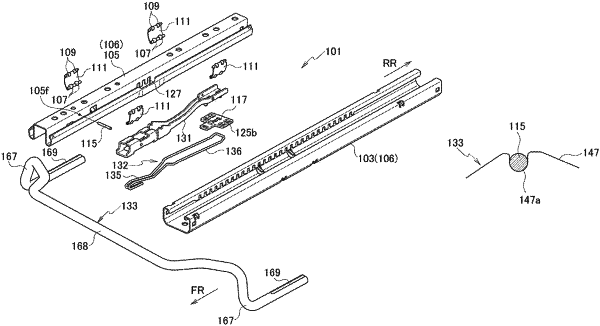| CPC B60N 2/085 (2013.01) [B60N 2/0705 (2013.01)] | 3 Claims |

|
1. A seat sliding device comprising:
a lower rail extending in a vehicle front-rear direction;
an upper rail configured to move relative to the lower rail in a longitudinal direction;
a lever member turnably supported about an axis in a left-right direction with respect to the upper rail;
a lock member provided in a rear end of the lever member and including lock portions configured to be movable between a lock position where the lock portions engage with locked portions formed in the lower rail and a lock release position where the lock portions come away from the locked portions;
a biasing member configured to bias the lock portions in a lock position direction; and
an operation member connected to a front end of the lever member, wherein
the upper rail includes a shaft member disposed in such a way as to straddle both left and right side walls of the upper rail,
the lever member includes:
a pair of left and right side walls extending relative to the upper rail in the longitudinal direction, at inner sides of both the left and right side walls of the upper rail; and
bearings provided at the pair of left and right side walls and engaging with the shaft member,
each of left and right bearings has a surface in contact with the shaft member at one point in an up-down direction by being biased by the biasing member, and
in the left and right bearings, a surface in contact with the shaft member in one bearing is formed as an arc-shaped surface with a radius slightly larger than an outer diameter of the shaft member, and a surface in contact with the shaft member in another bearing is formed as a flat surface extending relative to the upper rail in the longitudinal direction.
|